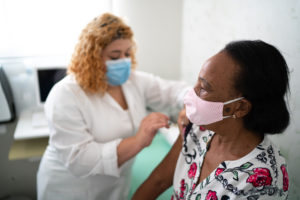
Northwest-based Marquis Companies not only already completed its third round of staff and resident COVID-19 vaccinations over the weekend, it also registered what could be the nation’s best 82% staff participation rate for a chain its size.
President and CEO Phil Fogg Jr. says the reasons for success are relatively simple. But he also cautioned that while many indicators are looking good regarding coronavirus mitigation efforts, eager providers nationwide must be careful about trying to return to “normal” routines.
Many aspects of pre-pandemic life in nursing facilities, including group dining, more transportation options and looser visitation policies, could resume in March if vaccination efforts continue their positive trend, Fogg told McKnight’s Long-Term Care News in an interview Wednesday.
“I think we can do it by March, I absolutely do,” said Fogg, who oversees Marquis’ 26 long-term care facilities and its affiliated Consonus Healthcare affiliate. The latter serves many more facilities nationwide. “The most important piece of this is to gather the data to demonstrate the efficacy of the vaccine, and get policy makers and regulators comfortable with that. Things will then open and we can get residents ‘de-isolated.’”
Due in part to its Consonus Pharmacy arm, Marquis became one of the first mid-sized providers to fully complete staff and resident vaccinations. Its 90% resident vaccination rate easily exceeds the 78% national average cited by the Centers for Disease Control and Prevention last week.
What is even more hailed, however, is the 82% vaccination rate for Marquis’ 2,700 employees. In comparison, the CDC cited a 38% average nursing home worker vaccination rate nationally. Many providers, especially larger groups, are struggling to get to 50% or higher. Most long-term care operators are battling worker mistrust of vaccines that they think either were developed too quickly or might produce undesirable side effects in the short or long term.

The secret to high compliance, Fogg told McKnight’s, was “inundating” staff with education and communication, delivered by the right messengers. That included prodigious, “masterful” video messaging from within, capitalizing on the company’s many long-time managers and clips featuring corporate leaders such as Chief Medical Officer Kathryn Kolonic and Vice President of Clinical Services April Diaz.
“We had really-respected faces known across the company, and then we leveraged some of our pharmacists to be in our videos. It wasn’t just a one-time thing,” he explained. “We had multiple communications, both video and written. We also used our text-alert system that was devised for families and others in the company. We basically inundated people with [information].”
Focus properly
Fogg said another key was not engaging in debates with “anti-vaxxers.”
“We didn’t want to waste a lot of energy on that group. No matter what you did, you wouldn’t get them comfortable, and it wasn’t actually the science that they were arguing,” he explained. “We wanted to focus on people sincerely concerned or afraid, who didn’t have enough information, and work with them.”
Cultural views and historical experiences have stifled vaccinations with some segments of society as a whole, Fogg acknowledged. He said that Marquis successfully persuaded many of its staff members with Hispanic, Russian or other roots to vaccinate. Rural areas had the lowest participation rates.
The bottom line is overall infection rates have dropped “dramatically,” Fogg said. A fuller picture will be known in about a week, but COVID cases are already down by 53%.
“It’s crazy, what we’re seeing with our facilities,” the vice chairman of the American Health Care Association Board of Directors added. “We have counties where we just got out of twice-a-week testing because they were in the ‘extreme’ category and we had just four positive tests in the last 10 days. And they were all staff who didn’t get vaccinated.”
‘Running’ back to normal?
Fogg said that the company hopes to start vaccinating residents’ family members soon, beyond any current screening or testing they have been undergoing. He hopes that states will make at least a few members in each family a priority group “under the philosophy of getting families reconnected with residents.”
But many decisions will hinge on vaccination rates since facilities with lower participation will continue to be much bigger threats to all involved. And visitation policies will be dictated at the state and local level.
“If you have a vaccinated resident population, why shouldn’t they be able to get together for dining and activities?” Fogg expressed. “Take some time to make sure the vaccine has worked, but it seems they should be able to resume. That’s what we’ve been advocating for. Even if it’s with masks except when they’re eating, that would be better.”
He said that this spring could mirror last spring, with frequent guidance and rule changes. Only this time it could be removing layers of restrictions rather than adding them.
“We have to be flexible and adaptable to manage the many changes again. This time it will be more positive. It is the road map back to normal, but it will be a bumpy road and require providers to be really adaptable. It might even be tougher (this spring) because of so many situations out there.
“That’s the big-picture message: Be prepared to adapt,” he continued. “Last year, it was like we were running uphill and it was slower. This year, coming downhill is going to be easier but in some ways it’s going to be faster and more dynamic.”




